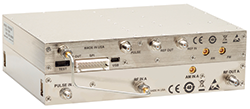
With the availability of low-cost integrated phase-locked loop (PLL) ICs, many families of miniature and low-cost frequency synthesizers are available. However, integrated and embedded test systems have always faced challenges in utilizing these new offerings. The conditions that small, portable applications face—especially those within the military and aerospace markets—are not limited to environmental factors such as flightline location, elevated temperature and vibration. The RF setting presents additional challenges because of load impedance uncertainties due to switches, varied lengths of transmission lines and other effects that degrade embedded systems testing and measurement accuracies. Miniature frequency synthesizers typically do not have closed-loop automatic level control (ALC), which mitigates the impact of an uncertain output impedance. While small synthesizers may have partial coverage at RF frequencies, imposing demands such as extended low frequency coverage or calibrated amplitude modulation (AM) makes miniature synthesizers impractical for embedded test requirements in many instances. Consequently, engineers are forced to either use benchtop synthesizers or develop internal designs, which increases the size, power consumption, cost and development time, and decreases the portability and flexibility of test systems.
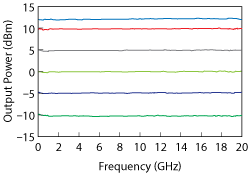
Figure 1 Leveled output power across the QuickSyn X’s frequency range from 250 kHz to 20 GHz.
To address these demands, National Instruments is introducing the QuickSyn X, the industry’s smallest, fast switching, full-function frequency generator. The QuickSyn X provides closed-loop ALC, extended low frequency coverage, calibrated AM and low power consumption, as well as being compact and low cost—without compromising any key performance metrics such as phase noise and frequency switching speed.
Expanded Frequency Range
QuickSyn X covers from 250 kHz to 20 GHz and does so without compromising any of its key performance metrics, including harmonic performance. Figure 1 shows the frequency coverage and output power; the synthesizer provides more than 20 dB output power control across its frequency range.
Closed-Loop Power Control
Closed-loop ALC was one of the most requested features, and the QuickSyn X allows both open-loop and closed-loop ALC. When fast frequency switching is desired, the unit can be placed in an open-loop mode; when more power control accuracy is desired or when the output power must be insensitive to varying load impedance, the closed-loop ALC can be used. Figure 2 shows a simplified block diagram of the ALC implementation in the QuickSyn X. The forward power is measured at the coupled port of a high-directivity directional coupler using a precision detector. This measurement is compared to the power programmed by the user, and an error signal is applied to a variable attenuator that adjusts the output power to compensate for any difference. Because of the high directivity of the directional coupler, the power delivered to the output is insensitive to load impedance variation.

Figure 2 Simplified block diagram of the QuickSyn X’s ALC implementation.
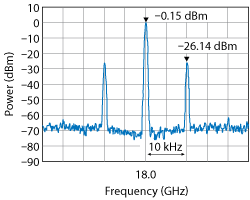
Figure 3 Spectrum of an 18 GHz carrier with 10 percent AM.
The closed-loop ALC amplitude control is greater than 10 dB, which is not possible with many small synthesizers. Also, by using an external attenuator module that allows for attenuation adjustment in 10 dB steps, the closed-loop ALC range of the QuickSyn X can be extended to a broad dynamic range from ‐100 to +10 dBm.
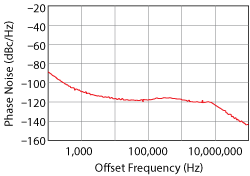
Figure 4 Phase noise of a 20 GHz output signal.
The synthesizer offers the power accuracy of closed-loop ALC when the carrier is being modulated. This is achieved using the conventional standard instrument protocol of the power search function. Using power search, carriers modulated with AM, pulse modulation or frequency modulation (FM) have the same power accuracy as with closed-loop ALC, without the closed-loop ALC conflicting with the modulation.
Instrument-Grade AM
Instrument-grade or calibrated AM can be critical for many use cases. QuickSyn X offers calibrated AM across its entire frequency range and a large power control range. Figure 3 shows an 18 GHz carrier with a power level of 0 dBm, modulated with 10 percent AM. A carrier-to-sideband level of ‐26.14 dB is observed, which reflects an AM index of 9.86 percent and an error from the programmed value of 1.4 percent.
Instrument-grade pulse modulation is one of QuickSyn X’s extended features, with a typical on-off ratio of 80 dB across the frequency range. The synthesizer provides multiple modes of FM and phase modulation, and each modulation may be used individually or in combination with any other modulation format. For example, pulse modulation may be combined with FM.
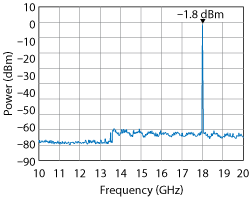
Figure 5 Spurious-free dynamic range of the QuickSyn X.
Spectral Purity, Fast Frequency Switching
QuickSyn X provides both fast frequency switching and low phase noise (see Figure 4). The typical phase noise at 10 kHz offset is better than ‐116 dBc/Hz. QuickSyn’s phase refining technology, which is based on fundamental VCOs up to 20 GHz, enables phase noise performance that is normally achieved with YIG technology and without the penalty of slow-tuning YIGs. In many cases, QuickSyn synthesizers have better phase noise than YIG-based synthesizers.
Using advanced direct digital synthesis spur-reduction technology, a frequency resolution of 0.001 Hz is achieved without incurring elevated spurs. A wide loop bandwidth makes the unit insensitive to microphonic effects. Figure 5 shows the spurious-free dynamic range of the QuickSyn X, with the synthesizer generating a CW signal at 18 GHz and the output measured with a spectrum analyzer from 10 to 20 GHz. Spurious emissions are better than ‐65 dBc. Due to the difficulty measuring spurious levels below this level, the spurious levels of the QuickSyn X are verified during manufacturing test at ‐60 dBc.
Good harmonic performance is achieved through harmonic filtering. At an output power of +10 dBm, the QuickSyn X’s harmonic levels below 100 MHz are roughly ‐30 dBc; above 100 MHz, harmonic performance is typically better than ‐40 dBc.
The synthesizer offers list mode operation, where the power and frequency can be incremented between consecutive measurements in any sequence, achieving extremely fast 200 µs switching times. The list mode is also available with external trigger control.
The QuickSyn X synthesizer uses a highly stable internal oven-controlled crystal oscillator (OCXO), factory calibrated to a GPS standard to ensure the accuracy of the synthesized signal. The internal oscillator frequency can be adjusted for aging and temperature variation. The unit provides a 10 MHz reference output, and the internal OCXO can be locked to an external reference.
Communications
The QuickSyn X supports multiple communication modes, including SPI, USB, Ethernet, GPIB and RS232. Like all QuickSyn synthesizers, it can also be controlled via a USB-based virtual-instrument graphical-user interface. The QuickSyn X family is capable of being controlled using the most-often used standard commands for programmable instruments (SCPI), since many legacy systems with aging frequency synthesizers are supported by SCPI programming platforms. This compatibility reduces the time and cost of integrating the latest synthesizer technology with SCPI software platforms.
CONCLUSION
The QuickSyn X gives system engineers tremendous versatility and flexibility by providing powerful capabilities in a small, light and power-efficient package, including closed- loop ALC and without compromising excellent phase noise and fast frequency switching. Measuring only 2 in × 7 in × 5 in, the QuickSyn X is a highly capable synthesizer on its own or a versatile building block in test and measurement systems for military and commercial applications.
National Instruments
Santa Clara, Calif.
www.ni-microwavecomponents.com
